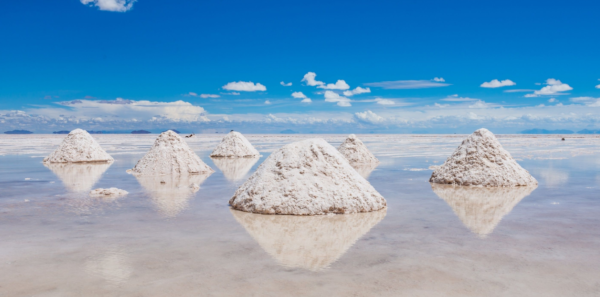Located in the southwest of Bolivia, near the crest of the Andes, the Salar de Uyuni on first glance seems like a vast open plain devoid of life or interesting features. However, look closer and it quickly becomes apparent that this is one of the most wondrous locations to visit in the world.
Salar de Uyuni is the world’s largest salt flat at 10,582 square kilometres (4,086 square miles) and sits at an elevation of 3,656 metres above sea level.
Formed as a result of the changes between several prehistoric lakes, it is covered by a few metres of salt crust that hides a pool of brine exceptionally rich in lithium. Unbelievably, it contains nearly 50% of the world’s known lithium reserves alone. The Salar also contains large amounts of sodium, potassium and magnesium.

Following rain, this expansive area of nothing but clear skies as far as the eye can see transforms into a breath-taking spectacle. A thin layer of completely calm water turns the Salar into the world’s largest natural mirror, giving it an eerie otherworldly feel. This phenomenon attracts many visitors each year between February and April (the rainy season in Bolivia), offering them a frankly humbling experience as they stand in the deafening silence in one of the loneliest places on Earth, staring into infinity.
Every November, the Salar becomes a major breeding ground for three species of pink flamingo: the Chilean, Andean and rarer James’s flamingos. The pink of these birds against the white of the salt flats is a sight to behold. Flamingos are not the only creatures to reside there either, with some 80 other bird species visiting the Salar. The Andean fox (known as a culpeo) can also be found roaming the flats, searching for the rabbit-like viscachas who make their homes on the ‘islands’ found in the Salar.
One major tourist attraction to be found in this desolate place is an antique train cemetery. Located 3 kilometres outside the city of Uyuni, which itself sits just to the southeast of the Salar, this industrial graveyard is a stark reminder of Bolivia’s difficulties in the 1940s. Rail construction started originally in 1888, encouraged by then Bolivian President Aniceto Arce, who believed that his country would flourish from having such a reliable transport system.
Uyuni became a distribution hub for the trains carrying minerals from the mining operations set up across the region, taking them to ports on the Pacific coast. This spike in industrial activity increased the population of Uyuni as rail engineers moved to the area, many of them coming from the UK.
Despite the aim being for the train service to carry passengers as well as cargo, the mining companies took precedence. However, problems soon began to arise when the local indigenous people (the Aymara) saw the railway network as an intrusion to their lives and so they constantly sabotaged trains and railways in defiance of this new industrial era.
However, in the 1940s, the mining industry collapsed, partly due to a depletion in minerals, and the trains were slowly abandoned, left to slumber on their tracks like sleeping metal behemoths. The Salar and the region around it became silent once more.
The Salar de Uyuni is unique. Where else can you walk on infinity while watching thousands of flamingos fly over a graveyard of locomotives?








